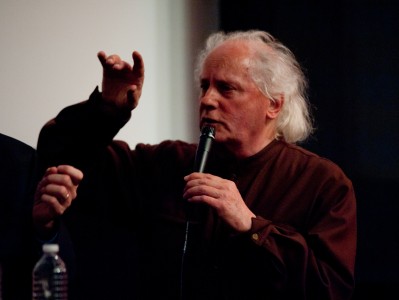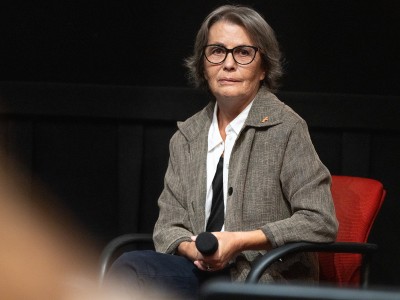
Roman Scandals introduction by David Pendleton and Sam Parler.
Transcript
John Quackenbush 0:00
December 17, 2016. The Harvard Film Archive screened Roman Scandals. This is the audio recording of the introduction by HFA programmer David Pendleton and Assistant Professor of Music History at Harvard, Samuel Parler.
David Pendleton
[INITIAL AUDIO MISSING] to Hollywood, Samuel Goldwyn contracted with Eddie Cantor to make musical films. And it seems to have been Cantor who suggested to Goldwyn that Busby Berkeley be brought out to do the dance numbers. Berkeley was, by that point, a successful choreographer on Broadway, and I don't see anywhere where Cantor and Berkeley worked together, but they obviously knew each other's work. And so, in the early 1930s, Berkeley did the dance numbers for four Eddie Cantor star vehicles, produced by Samuel Goldwyn. Roman Scandals, Palmy Days, Whoopee!, and The Kid from Spain, although that's not in chronological order. The one we're going to see tonight is the last one, Roman Scandals. I'm keeping our fingers crossed, we've been promised a rare 35mm print of Whoopee! from Gosfilmofond, the Russian Film Archive. And so, I'm keeping my fingers crossed that that will show up, and that that will be in excellent shape. If not, we have some other copies that we can show. But that one's a rarity, in part because of its two-strip Technicolor.
In any case, talking about Eddie Cantor, and talking about a number of Berkeley's musicals leads us to confront the question of the minstrel show and blackface, since there is the famous musical number involving blackface in Roman Scandals and there's one in each of the Eddie Cantor vehicles that we're going to be seeing. And given the current political climate, as well as discussions within the film world about race in front of and behind the camera, as well as women in front of and behind the camera. It seemed appropriate to have a sort of historical introduction, to explain a little bit about where blackface comes from. And this particular film gives us an opportunity to think about the relationship between race and gender, given the number itself. So, to do that, this evening, we have with us Samuel Parler, who is a doctoral candidate here at Harvard, in the Music department, who's working on race in early American popular culture. He attended a seminar given by Carol Oja on blackface a couple of years ago, and was the Teaching Fellow for that course and the curator of an exhibit of blackface materials from the Harvard Theatre Collection. And so, he's the perfect person to come and talk for a few minutes about minstrelsy and blackface. So please welcome Simon Parler.
[APPLAUSE]
Samuel Parler 3:08
Hi, everyone. As David mentioned, I've been asked to make some brief introductory remarks to the use of blackface in Roman Scandals and what the film can tell us about racial politics in the United States in the 1930s. For those of you unfamiliar with this practice, blackface refers to white actors applying, literally, black makeup to their faces, then acting out stereotypes of African American culture, and this usually included musical performances that used supposedly Black dialect. And here's a moment from Roman Scandals to show you what this looks like. Blackface in Roman Scandals is confined to a single musical number entitled “Keep Young and Beautiful.” The scene takes place inside a Roman bathhouse, where white women are being primped by Black slaves. On the run from authorities, Eddie Cantor's character, seen here, disguises himself in blackface and poses as a quote unquote, “Ethiopian beauty specialist.” Before we watch the scene later this evening, I want to highlight for you the juxtaposition of Black, blackface, and white characters in the scene. The juxtaposition is used, I think, to assert standards of female beauty that equate white skin with desirability, while Black skin is made to seem inferior.
First, to give a little bit of historical context, the blackface minstrel show began in the 1830s and 1840s, achieving its initial popularity in white working-class audiences, mostly in the urban North, so places like New York and Boston, which I think is surprising to people, given the history of slavery. After the Civil War, the minstrel show grew into mainstream middle-class entertainment throughout the country and by the 1920s, blackface had been adapted into vaudeville, onto radio and into films, as we'll see. In explaining the popularity of blackface, scholars have argued that it reinforced racial segregation and notions of white supremacy, while also allowing white audiences to explore and even celebrate certain aspects of Black culture, albeit in a demeaning fashion. Because blackface upheld the idea of a Black/white racial binary, it was also helpful to European immigrants as they sought to assimilate into white American society. By putting on blackface, Irish, Italian, Jewish and other so-called ethnic whites became merely white by virtue of being non-Black. Jewish performers like Al Jolson and Eddie Cantor benefited hugely from their blackface act, which made them seem more American and helped them to avoid anti-Semitic criticism. And this here is an example of Al Jolson performing in blackface in “Swanee River.” And as you can see, it's also kind of a “rah-rah, America's wonderful” number they're singing, Steven Foster.
Although blackface performance was primarily about race, minstrel shows also sometimes addressed issues of sex and gender, and Roman Scandals is participating in this particular tradition. Early minstrel shows often included so-called “wench shows,” in which white men dressed up as Black women, and in many ways this was a precursor to today's drag queens. Performers exaggerated facial and bodily features, and sang in falsetto, usually for comedic effect. The mammy character was a particularly popular stereotype. You can see at the top left, in the center, that's a mammy character, and then it was also a very popular image in advertising. Accompanied by misogynist jokes, these types of portrayals were often unflattering and used to make Black women seem unattractive, ill-tempered and ridiculous.
The scene in Roman Scandals avoids the worst of these tendencies, but it still works to devalue Black women by upholding whiteness as the ideal of female beauty. As we'll see, Cantor begins his blackface female impersonation fully in character, with a high voice and supposedly Black dialect. The impersonation fades, however, when Cantor begins singing the song “Keep Young and Beautiful.” His voice drops to a man's range, and he loses the dialect. And even the song doesn't sound particularly “Black.” Instead of a minstrel song, we’re treated to a typically Busby Berkeley-esque spectacle of dancing chorus girls. The white women sing to one another, and to the film audience, sharing beauty secrets and advising women to quote “keep young and beautiful if you want to be loved.” As they do this, the camera lingers on glamorous close-ups of their bodies, all uniformly young, trim, blonde, and white. In addition to Cantor and the white beauties, the scene also includes Black slaves. These women are unglamorous as they work to groom their white counterparts. The juxtaposition between Black and white skins is visually quite striking, I think. And the contrast again serves to emphasize whiteness as the more desirable appearance. And just to give you a couple of examples, so here we can see Eddie Cantor surrounded by these, you know, beautiful blonde women, and he's supposed to look ridiculous, obviously. Then later on, you know, there are a few scenes with the women that are basically being serviced by, you know, Black hands, in this case, and by Black women.
As was typical for Hollywood during this period, the Black actors in this scene have no speaking or singing roles. They're merely functional, subordinate characters, reproducing on screen the racial hierarchies of labor and beauty that persisted in the era of Jim Crow segregation. So far, I've presented a fairly stark interpretation of the scene. But as a closing thought, I want to suggest the possibility that Berkeley may also have been using these racial juxtapositions to ironic effect. The white women singing the praises of youth sometimes appear bored or exhausted by their beauty regimen. On the other hand, the Black actors sometimes appear to break the fourth wall, casting knowing glances at the camera that seem to comment on the artificiality and absurdity of the scene. And this is one of those moments: you can see the woman third from left sort of grinning at the camera, as if to say, you know, peeking between the legs, as if to say, this is like a ridiculous premise going on. So look for those moments. The possibility of parody here perhaps blunts the power dynamics that are ultimately on display, that of silent, devalued Black bodies laboring in the service of idealized whiteness. I'll leave it to you to decide whether this number is ironic or not. But in appreciating that ambivalence, we should keep in mind that wrapped up in Busby Berkeley's magic come sometimes problematic racial and gender politics with consequences that reach far beyond the screen. Thank you.
[APPLAUSE]
© Harvard Film Archive
Related film series
Explore more conversations
Adrian Staehli

Paolo Gioli

Rita Azevedo Gomes

Albert Serra

